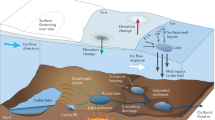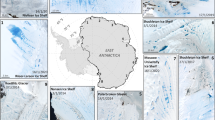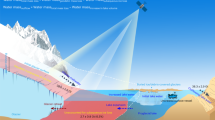Abstract
Supraglacial lakes (SGLs) form annually on the Greenland ice sheet1,2 and, when they drain, their discharge enhances ice-sheet flow3 by lubricating the base4 and potentially by warming the ice5. Today, SGLs tend to form within the ablation zone, where enhanced lubrication is offset by efficient subglacial drainage6,7. However, it is not clear what impact a warming climate will have on this arrangement. Here, we use an SGL initiation and growth8 model to show that lakes form at higher altitudes as temperatures rise, consistent with satellite observations9. Our simulations show that in southwest Greenland, SGLs spread 103 and 110 km further inland by the year 2060 under moderate (RCP 4.5) and extreme (RCP 8.5) climate change scenarios, respectively, leading to an estimated 48–53% increase in the area over which they are distributed across the ice sheet as a whole. Up to half of these new lakes may be large enough to drain, potentially delivering water and heat to the ice-sheet base in regions where subglacial drainage is inefficient. In such places, ice flow responds positively to increases in surface water delivered to the bed through enhanced basal lubrication4,10,11 and warming of the ice5, and so the inland advance of SGLs should be considered in projections of ice-sheet change.
This is a preview of subscription content, access via your institution
Access options
Subscribe to this journal
Receive 12 print issues and online access
$209.00 per year
only $17.42 per issue
Buy this article
- Purchase on Springer Link
- Instant access to full article PDF
Prices may be subject to local taxes which are calculated during checkout



Similar content being viewed by others
References
Leeson, A. A. et al. A comparison of supraglacial lake observations derived from MODIS imagery at the western margin of the Greenland ice sheet. J. Glaciol. 59, 1179–1188 (2013).
Lampkin, D. J. & VanderBerg, J. A preliminary investigation of the influence of basal and surface topography on supraglacial lake distribution near Jakobshavn Isbrae, western Greenland. Hydrol. Process. 25, 3347–3355 (2011).
Das, S. B. et al. Fracture propagation to the base of the Greenland ice sheet during supraglacial lake drainage. Science 320, 778–781 (2008).
Zwally, H. J. et al. Surface melt-induced acceleration of Greenland ice-sheet flow. Science 297, 218–222 (2002).
Phillips, T., Rajaram, H. & Steffen, K. Cryo-hydrologic warming: A potential mechanism for rapid thermal response of ice sheets. Geophys. Res. Lett. 37, L20503 (2010).
Sole, A. et al. Winter motion mediates dynamic response of the Greenland ice sheet to warmer summers. Geophys. Res. Lett. 40, 3940–3944 (2013).
Sundal, A. V. et al. Melt-induced speed-up of Greenland ice sheet offset by efficient subglacial drainage. Nature 469, 522–524 (2011).
Leeson, A. A., Shepherd, A., Palmer, S., Sundal, A. & Fettweis, X. Simulating the growth of supraglacial lakes at the western margin of the Greenland ice sheet. Cryosphere 6, 1077–1086 (2012).
Howat, I. M., de la Peña, S., van Angelen, J. H., Lenaerts, J. T. M. & van den Broeke, M. R. Expansion of meltwater lakes on the Greenland ice sheet. Cryosphere 7, 201–204 (2013).
Schoof, C. Ice-sheet acceleration driven by melt supply variability. Nature 468, 803–806 (2010).
Doyle, S. H. et al. Persistent flow acceleration within the interior of the Greenland ice sheet. Geophys. Res. Lett. 41, 899–905 (2014).
Selmes, N., Murray, T. & James, T. D. Characterizing supraglacial lake drainage and freezing on the Greenland ice sheet. Cryosphere Discuss. 7, 475–505 (2013).
Van der Veen, C. J. Fracture propagation as means of rapidly transferring surface meltwater to the base of glaciers. Geophys. Res. Lett. 34, L01501 (2007).
Meierbachtol, T., Harper, J. & Humphrey, N. Basal drainage system response to increasing surface melt on the Greenland ice sheet. Science 341, 777–779 (2013).
Chandler, D. M. et al. Evolution of the subglacial drainage system beneath the Greenland ice sheet revealed by tracers. Nature Geosci. 6, 195–198 (2013).
Hanna, E., Mernild, S. H., Cappelen, J. & Steffen, K. Recent warming in Greenland in a long-term instrumental (1881–2012) climatic context: I. Evaluation of surface air temperature records. Env. Res. Lett. 7, 045404 (2012).
Fettweis, X. et al. Important role of the mid-tropospheric atmospheric circulation in the recent surface melt increase over the Greenland ice sheet. Cryosphere 7, 241–248 (2013).
Fettweis, X. et al. Estimating the Greenland ice sheet surface mass balance contribution to future sea level rise using the regional atmospheric climate model MAR. Cryosphere 7, 469–489 (2013).
Van Vuuren, D. P. et al. The representative concentration pathways: An overview. Climatic Change 109, 5–31 (2011).
Tedesco, M. et al. Measurement and modeling of ablation of the bottom of supraglacial lakes in western Greenland. Geophys. Res. Lett. 39, L02502 (2012).
Krawczynski, M. J., Behn, M. D., Das, S. B. & Joughin, I. Constraints on the lake volume required for hydro-fracture through ice sheets. Geophys. Res. Lett. 36, L10501 (2009).
Shreve, R. L. Movement of water in glaciers. J. Glaciol. 11, 205–214 (1972).
Church, J. A. et al. in Climate Change 2013: The Physical Science Basis (eds Stocker, T. F. et al.) Ch. 13, 1137–1216 (IPCC, Cambridge Univ. Press, 2013).
Parizek, B. R. & Alley, R. B. Implications of increased Greenland surface melt under global-warming scenarios: Ice sheet simulations. Quat. Sci. Rev. 23, 1013–1027 (2004).
Shannon, S. R. et al. Enhanced basal lubrication and the contribution of the Greenland ice sheet to future sea-level rise. Proc. Natl Acad. Sci. USA 110, 14156–14161 (2013).
Belleflamme, A., Fettweis, X., Lang, C. & Erpicum, M. Current and future atmospheric circulation at 500 hPa over Greenland simulated by the CMIP3 and CMIP5 global models. Clim. Dynam. 41, 2061–2080 (2012).
Vaughan, D. G. Tidal flexure at ice shelf margins. J. Geophys. Res. 100, 6213–6224 (1995).
Zwally, H. J. & Giovinetto, M. B. Balance mass flux and ice velocity across the equilibrium line in drainage systems of Greenland. J. Geophys. Res. 106, 33717–33728 (2001).
Morlighem, M., Rignot, E., Mouginot, J., Seroussi, H. & Larour, E. Deeply incised submarine glacial valleys beneath the Greenland ice sheet. Nature Geosci. 7, 418–42 (2014).
Acknowledgements
This work was supported by the UK National Centre for Earth Observation. We also acknowledge M. van den Broeke who supplied surface mass balance estimates produced using the RACMO model to I.H.
Author information
Authors and Affiliations
Contributions
A.A.L. and A.S. designed the research. A.A.L. wrote and developed the SLInG model and performed all simulations/analysis. K.B. and A.A.L. created the surface DEM used as input into the SLInG model. X.F. provided runoff data from MAR simulations. M.M. and E.R. provided the bedrock DEM. I.H. provided satellite observations and equilibrium line altitude estimates. A.A.L. and A.S. wrote the paper. All authors discussed the results and commented on the manuscript.
Corresponding author
Ethics declarations
Competing interests
The authors declare no competing financial interests.
Supplementary information
Rights and permissions
About this article
Cite this article
Leeson, A., Shepherd, A., Briggs, K. et al. Supraglacial lakes on the Greenland ice sheet advance inland under warming climate. Nature Clim Change 5, 51–55 (2015). https://doi.org/10.1038/nclimate2463
Received:
Accepted:
Published:
Issue Date:
DOI: https://doi.org/10.1038/nclimate2463
This article is cited by
-
Firn on ice sheets
Nature Reviews Earth & Environment (2024)
-
Mass Balances of the Antarctic and Greenland Ice Sheets Monitored from Space
Surveys in Geophysics (2023)
-
Increased variability in Greenland Ice Sheet runoff from satellite observations
Nature Communications (2021)
-
Diurnal expansion and contraction of englacial fracture networks revealed by seismic shear wave splitting
Communications Earth & Environment (2021)
-
Measurement of ice flow velocities from GPS positions logged by short-period seismographs in East Antarctica
Science China Earth Sciences (2021)



